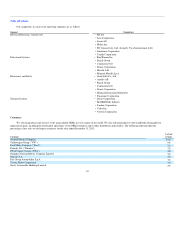DELPHI 2011 Annual Report Download - page 21
Download and view the complete annual report
Please find page 21 of the 2011 DELPHI annual report below. You can navigate through the pages in the report by either clicking on the pages listed below, or by using the keyword search tool below to find specific information within the annual report.
Table of Contents
small single subcomponent necessary to manufacture one of our products, for whatever reason, could force us to cease production, even for a prolonged
period. Similarly, a potential quality issue could force us to halt deliveries while we validate the products. Even where products are ready to be shipped, or
have been shipped, delays may arise before they reach our customer. Our customers may halt or delay their production for the same reason if one of their
other suppliers fails to deliver necessary components. This may cause our customers, in turn to suspend their orders, or instruct us to suspend delivery, of our
products, which may adversely affect our financial performance.
When we fail to make timely deliveries in accordance with our contractual obligations, we generally have to absorb our own costs for identifying and
solving the "root cause" problem as well as expeditiously producing replacement components or products. Generally, we must also carry the costs associated
with "catching up," such as overtime and premium freight.
Additionally, if we are the cause for a customer being forced to halt production, the customer may seek to recoup all of its losses and expenses from us.
These losses and expenses could be significant, and may include consequential losses such as lost profits. Any supply-chain disruption, however small, could
potentially cause the complete shutdown of an assembly line of one of our customers, and any such shutdown that is due to causes that are within our control
could expose us to material claims of compensation. Where a customer halts production because of another supplier failing to deliver on time, it is unlikely we
will be fully compensated, if at all.
Adverse developments affecting one or more of our suppliers could harm our profitability.
Any significant disruption in our supplier relationships, particularly relationships with sole-source suppliers, could harm our profitability. Furthermore,
some of our suppliers may not be able to handle the commodity cost volatility and/or sharply changing volumes while still performing as we expect. To the
extent our suppliers experience supply disruptions, there is a risk for delivery delays, production delays, production issues or delivery of non-conforming
products by our suppliers. Even where these risks do not materialize, we may incur costs as we try to make contingency plans for such risks.
The loss of business with respect to, or the lack of commercial success of, a vehicle model for which we are a significant supplier could adversely affect
our financial performance.
Although we receive purchase orders from our customers, these purchase orders generally provide for the supply of a customer's requirements for a
particular vehicle model and assembly plant, rather than for the purchase of a specific quantity of products. The loss of business with respect to, or the lack of
commercial success of, a vehicle model for which we are a significant supplier could reduce our sales and thereby adversely affect our financial condition,
operating results and cash flows.
We operate in the highly competitive automotive supply industry.
The global automotive component supply industry is highly competitive. Competition is based primarily on price, technology, quality, delivery and
overall customer service. There can be no assurance that our products will be able to compete successfully with the products of our competitors. Furthermore,
the rapidly evolving nature of the markets in which we compete may attract new entrants, particularly in low-cost countries such as China, Brazil, India and
Russia. Additionally, consolidation in the automotive industry may lead to decreased product purchases from us. As a result, our sales levels and margins
could be adversely affected by pricing pressures from OEMs and pricing actions of competitors. These factors led to selective resourcing of business to
competitors in the past and may also do so in the future. In addition, any of our competitors may foresee the course of market development more accurately
than us, develop products that are superior to our products, have the ability to produce similar products at a lower cost than us, or adapt more quickly than us
to new technologies or evolving customer requirements. As a result, our products may not be able to compete successfully with their products. These trends
may adversely affect our sales as well as the profit margins on our products.
20
























